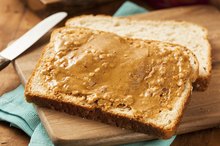Counting Points Diet
Diet points, developed by Weight Watchers, factor in calories, fat and fiber to determine a point value for each food 2. Foods with high fat carry more points than foods with high fiber. Your total daily point intake is your starting weight, and additional points are allowed for increased activity. Counting points is similar to counting calories but encourages a reduced-fat and higher-fiber intake for a healthy diet.
Size
Your daily points range is based on your weight and may be adjusted as you lose weight and move toward your goal. If you start your diet weighing less than 150 pounds, you are allowed 18 to 23 points per day. Between 150 and 174 pounds, you may have 20 to 25 points per day. From 175 to 199 pounds, your allowance is 22 to 27 points a day. Point allowances increase in a similar fashion for each 25 pounds of weight, according to WatchersPoints.com.
- Your daily points range is based on your weight and may be adjusted as you lose weight and move toward your goal.
- Between 150 and 174 pounds, you may have 20 to 25 points per day.
Considerations
What Are the Weight Watchers Points for a Publix Cupcake?
Learn More
One Weight Watchers point is about 50 calories 2. Add one point for every 12 g of fat and deduct up to one point for a high-fiber food, according to WatchersPoints.com. This calculation enables many vegetables to qualify as zero-point foods, or free foods, on the diet plan. Other foods may be very low in points but help to fill you up and increase satisfaction with the diet.
- One Weight Watchers point is about 50 calories 2.
- Add one point for every 12 g of fat and deduct up to one point for a high-fiber food, according to WatchersPoints.com.
Function
If you count points, you will successfully limit your calories and fat intake. Reducing calories is a proven weight-loss method and one that can be used while including all food groups in a varied and healthy diet 2. A 3,500-calorie deficit will typically produce a 1-lb. weight loss 12. Staying within your recommended point allowances creates a calorie deficit and should produce a healthy weight loss 12 of 1 to 2 lbs. each week.
Significance
How Many Points a Day for Weight Watchers?
Learn More
Choosing low-point foods can allow you to feel comfortable and satisfied while dieting. Sweets, high-fat foods and refined carbohydrates are typically high in points. Low-point foods include most fruits and vegetables, lean meat, fat-free dairy products and whole grains. Counting points may help you learn to make better food choices and eat a healthier and more balanced diet, encouraging you to maintain weight loss 12 over the long term.
- Choosing low-point foods can allow you to feel comfortable and satisfied while dieting.
- Sweets, high-fat foods and refined carbohydrates are typically high in points.
Warning
While Weight Watchers is a proven and successful diet strategy, counting points on your own may not work as well 2. If you opt for meetings or Weight Watchers online, you have a support system, access to information and accountability in place 2. While you can count points and use the Weight Watchers strategy, you may find the additional services offered by the Weight Watchers organization helpful 2.
Related Articles
References
- Weight Watchers: Weight-Loss Math Made Simple
- Diet.com: Weight Watchers
- Ahern AL, Wheeler GM, Aveyard P, et al. Extended and standard duration weight-loss programme referrals for adults in primary care (WRAP): a randomised controlled trial [published correction appears in Lancet. 2017 Jun 3;389(10085):2192]. Lancet. 2017;389(10085):2214–2225. doi:10.1016/S0140-6736(17)30647-5
- Gudzune KA, Doshi RS, Mehta AK, et al. Efficacy of commercial weight-loss programs: an updated systematic review [published correction appears in Ann Intern Med. 2015 May 19;162(10):739-40]. Ann Intern Med. 2015;162(7):501–512. doi:10.7326/M14-2238
- Gorin AA, Lenz EM, Cornelius T, Huedo-Medina T, Wojtanowski AC, Foster GD. Randomized Controlled Trial Examining the Ripple Effect of a Nationally Available Weight Management Program on Untreated Spouses. Obesity (Silver Spring). 2018;26(3):499–504. doi:10.1002/oby.22098
- Piper C, Marossy A, Griffiths Z, Adegboye A. Evaluation of a type 2 diabetes prevention program using a commercial weight management provider for non-diabetic hyperglycemic patients referred by primary care in the UK. BMJ Open Diabetes Res Care. 2017;5(1):e000418. Published 2017 Oct 16. doi:10.1136/bmjdrc-2017-000418
- Piper C, Marossy A, Griffiths Z, Adegboye A. Evaluation of a type 2 diabetes prevention program using a commercial weight management provider for non-diabetic hyperglycemic patients referred by primary care in the UK. BMJ Open Diabetes Res Care. 2017;5(1):e000418. Published 2017 Oct 16. doi:10.1136/bmjdrc-2017-000418
- O’Neil et al. Randomized controlled trial of a nationally available weight control program tailored for adults with type 2 diabetes. Obesity (Silver Spring). 2016 Nov;24(11):2269-2277.
- Mehta AK, Doshi RS, Chaudhry ZW, et al. Benefits of commercial weight-loss programs on blood pressure and lipids: a systematic review. Prev Med. 2016;90:86–99. doi:10.1016/j.ypmed.2016.06.028
Writer Bio
With a master's degree in art history from the University of Missouri-Columbia, Michelle Powell-Smith has been writing professionally for more than a decade. An avid knitter and mother of four, she has written extensively on a wide variety of subjects, including education, test preparation, parenting, crafts and fashion.








